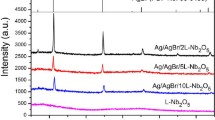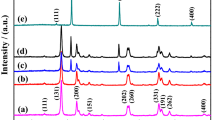Abstract
Ag-modified BiOBr composite photocatalysts were prepared via a simple phase-transfer methodology and used for cleanup of Rhodamine B (RhB) aqueous solution under visible light irradiation. X-ray diffraction, ultraviolet–visible diffuse reflectance spectra (UV–Vis-DRS) and high resolution X-ray photoelectron spectra characterizations confirmed the Ag-modification significantly affected the optical property, structures and reactivity of the BiOBr-based photocatalysts. In the Ag-modification process, a large portion of Ag+ may extract Br1− from BiOBr and the as-formed AgBr epitaxially located along the {102} crystal surface of BiOBr. The rest Ag+ will be either photo-reduced by methanol into Ag0 or form Ag2O. In nature, the Ag-modified BiOBr materials are multi-junction photocatalysts of Ag/Ag2O/AgBr/BiOBr. The Ag-modification can greatly enhance the absorption of visible light but deteriorates the photocatalytic activity in comparison to the primitive BiOBr in visible-light-driven photodegradation of RhB. The activity of RhB photodegradation on such catalysts is inversely proportional to AgBr loading within 0.2–2.0 wt% region. Such unusual photocatalytic performance was tentatively attributed to the special band structure of the materials.
Graphical Abstract
Ag-modified BiOBr photocatalysts have been prepared via a photodeposition synthesis and used for visible-light-responsive photodegradation of refractory Rh.B. The metallic Ag, AgBr and Ag2O species were formed on the p-type BiOBr in the synthesis process and significantly affected their photocatalytic performance. The unusual photocatalytic performance of such photocatalysts was tentatively attributed to their multi-junction structure on basis of experimental evidence and theoretical analysis.







Similar content being viewed by others
References
Pan JH, Dou H, Xiong Z, Xu C, Ma J, Zhao XS (2010) Porous photocatalysts for advanced water purifications. J Mater Chem 20:4512–4528
Jiang Z, Xiao T, Kuznetsov VL, Edwards PP (2010) Turning carbon dioxide into fuel. Philos Trans R Soc A 368:3343–3364
Han F, Kambala VSR, Srinivasan M, Rajarathnam D, Naidu R (2009) Tailored titanium dioxide photocatalysts for the degradation of organic dyes in wastewater treatment: a review. Appl Catal A 359:25–40
Hernandez-Alonso MD, Fresno F, Suarez S, Coronado JM (2009) Development of alternative photocatalysts to TiO2: challenges and opportunities. Energy Environ Sci 2:1231–1257
Kou JH, Gao J, Li ZS, Zou ZG (2010) Research on photocatalytic degradation properties of organics with different new photocatalysts. Curr Org Chem 14:728–744
Jiang Z, Al-Shahrani F, Lin T-W, Cui Y, Xiao T (2007) Visible light activated mesoporous TiO2–xNx nanocrystalline photocatalyst. In: Dongyuan Zhao SQYT, Chengzhong Y (eds) Studies in surface science and catalysis, vol 165. Elsevier, Amsterdam, pp 355–359
Jiang Z, Yang F, Luo N, Chu BTT, Sun D, Shi H, Xiao T, Edwards PP (2008) Solvothermal synthesis of N-doped TiO2 nanotubes for visible-light-responsive photocatalysis. Chem Commun 1(47):6372–6374
Luo N, Jiang Z, Shi H, Cao F, Xiao T, Edwards PP (2009) Photo-catalytic conversion of oxygenated hydrocarbons to hydrogen over heteroatom-doped TiO2 catalysts. Int J Hydrogen Energy 34:125–129
Kong L, Jiang Z, Xiao T, Lu L, Jones MO, Edwards PP (2011) Exceptional visible-light-driven photocatalytic activity over BiOBr–ZnFe2O4 heterojunctions. Chem Commun 47:5512–5514
Jiang Z, Yang F, Yang G, Kong L, Jones MO, Xiao T, Edwards PP (2010) The hydrothermal synthesis of BiOBr flakes for visible-light-responsive photocatalytic degradation of methyl orange. J Photochem Photobiol A Chem 212:8–13
Wang W, Huang F, Lin X, Yang J (2008) Visible-light-responsive photocatalysts xBiOBr–(1 − x)BiOI. Catal Commun 9:8–12
Huang WL, Zhu Q (2009) Structural and electronic properties of BiOX (X = F, Cl, Br, I) considering Bi 5f states. Comput Mater Sci 46:1076–1084
Jia Z, Wang F, Xin F, Zhang B (2011) Simple solvothermal routes to synthesize 3D BiOBrxI1−x microspheres and their visible-light-induced photocatalytic properties. Ind Eng Chem Res 50:6688–6694
Hu C, Lan Y, Qu J, Hu X, Wang A (2006) Ag/AgBr/TiO2 visible light photocatalyst for destruction of azodyes and bacteria. J Phys Chem B 110:4066–4072
Herrmann J-M, Tahiri H, Ait-Ichou Y, Lassaletta G, González-Elipe AR, Fernández A (1997) Characterization and photocatalytic activity in aqueous medium of TiO2 and Ag-TiO2 coatings on quartz. Appl Catal B 13:219–228
Zhang L, Wong K-H, Chen Z, Yu JC, Zhao J (2009) AgBr–Ag–Bi2WO6 nanojunction system: a novel and efficient photocatalyst with double visible-light active components. Appl Catal A Gen 363:221–229
Wang P, Huang B, Zhang Q, Zhang X, Qin X, Dai Y, Zhan J, Yu J, Liu H, Lou Z (2010) Highly efficient visible light plasmonic photocatalyst Ag@AgBr. Chem A Eur J 15:1821–1824
Cheng H, Huang B, Dai Y, Qin X, Zhang X (2010) One-step synthesis of the nanostructured AgI/BiOI composites with highly enhanced visible-light photocatalytic performances. Langmuir 26:6618–6624
Cheng H, Huang B, Wang P, Wang Z, Lou Z, Wang J, Qin X, Zhang X, Dai Y (2011) In situ ion exchange synthesis of the novel Ag/AgBr/BiOBr hybrid with highly efficient decontamination of pollutants. Chem Commun 47(25):7054–7056
Butler MA (1977) Photoelectrolysis and physical properties of the semiconducting electrode WO2. J Appl Phys 48(5):1914–1920
Tang J, Ye J (2005) Photocatalytic and photophysical properties of visible-light-driven photocatalyst ZnBi12O20. Chem Phys Lett 410:104–107
Zhang K-L, Liu C-M, Huang F-Q, Zheng C, Wang W-D (2006) Study of the electronic structure and photocatalytic activity of the BiOCl photocatalyst. Appl Catal B 68:125–129
Tian G, Chen Y, Bao H-L, Meng X, Pan K, Zhou W, Tian C, Wang J-Q, Fu H (2012) Controlled synthesis of thorny anatase TiO2 tubes for construction of Ag–AgBr/TiO2 composites as highly efficient simulated solar-light photocatalyst. J Mater Chem 22(5):2081–2088
Strydom CA, Van Staden JF, Strydom HJ (1991) An XPS investigation of silver bromide-coated ion-selective electrodes. Electroanalysis 3:815–821
Tjeng LH, Meinders MBJ, van Elp J, Ghijsen J, Sawatzky GA, Johnson RL (1990) Electronic structure of Ag2O. Phys Rev B 41:3190–3199
Kaushik VK (1991) XPS core level spectra and Auger parameters for some silver compounds. J Electron Spectrosc Relat Phenom 56:273–277
Moulder JF, Stickle WF, Sobol PE, Bomben KD (1992) Handbook of X-ray photoelectron spectroscopy. Perkin Elmer Corporation Physical Electronics Division, Eden Prairie
Dharmadhikari VS, Sainkar SR, Badrinarayan S, Goswami A (1982) Characterisation of thin films of bismuth oxide by X-ray photoelectron spectroscopy. J Electron Spectrosc Relat Phenom 25:181–189
Yu K, Yang S, He H, Sun C, Gu C, Ju Y (2009) Visible light-driven photocatalytic degradation of Rhodamine B over NaBiO3: pathways and mechanism. J Phys Chem A 113:10024–10032
Acknowledgments
This work was financially supported by the principal’s major fund at Jesus College, University of Oxford, Oxford Challenge Seed Fund and UK Photocatalysis Network. Jiang appreciates Sir John Houghton Fellowship at Jesus College (Oxford), Shell Foundation, and the grants of Royal Society (TG092414 and TG101750). Lufeng thanks the financial support from Sinopec, China.
Author information
Authors and Affiliations
Corresponding authors
Rights and permissions
About this article
Cite this article
Lu, L., Kong, L., Jiang, Z. et al. Visible-Light-Driven Photodegradation of Rhodamine B on Ag-Modified BiOBr. Catal Lett 142, 771–778 (2012). https://doi.org/10.1007/s10562-012-0824-2
Received:
Accepted:
Published:
Issue Date:
DOI: https://doi.org/10.1007/s10562-012-0824-2




